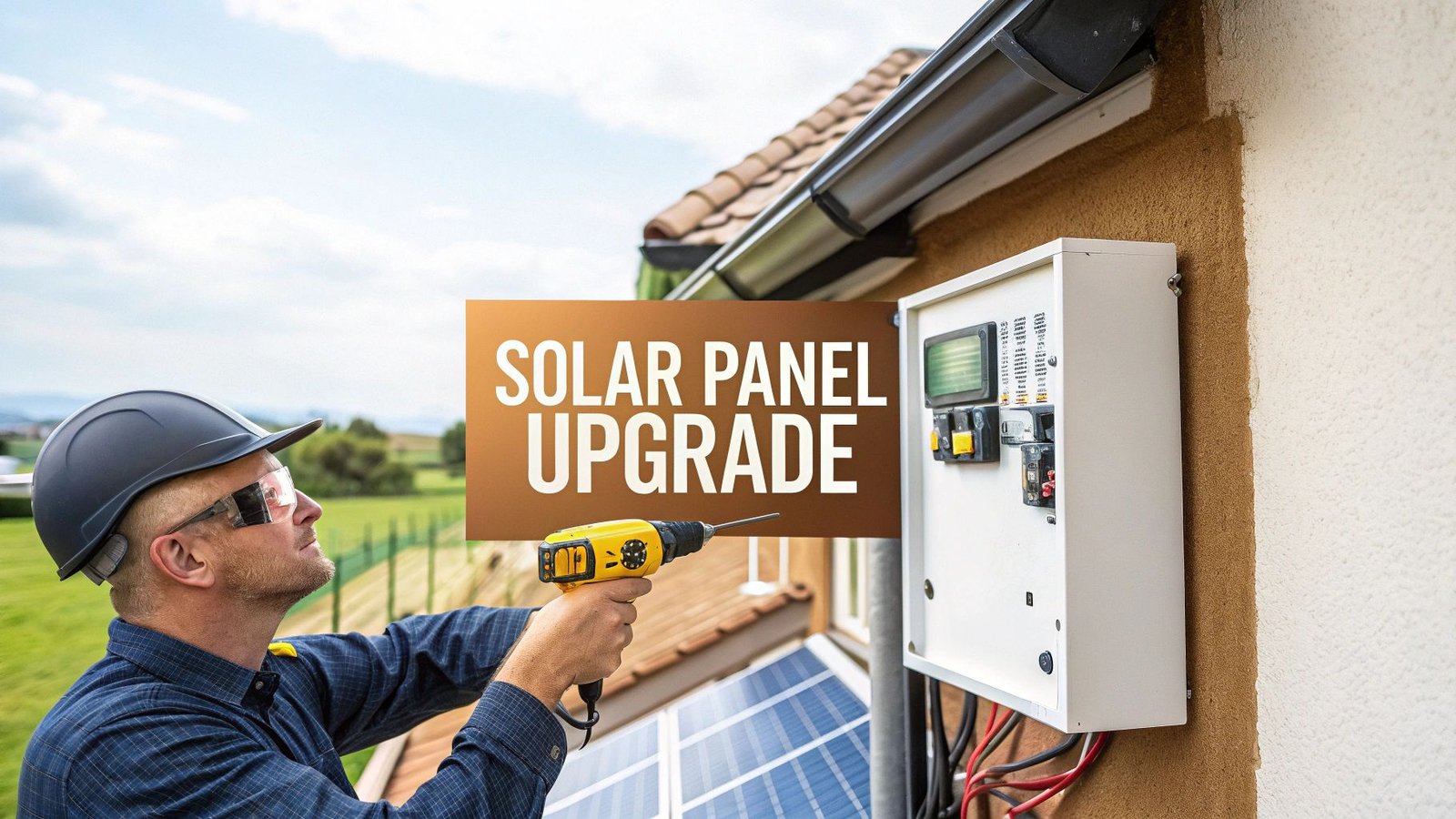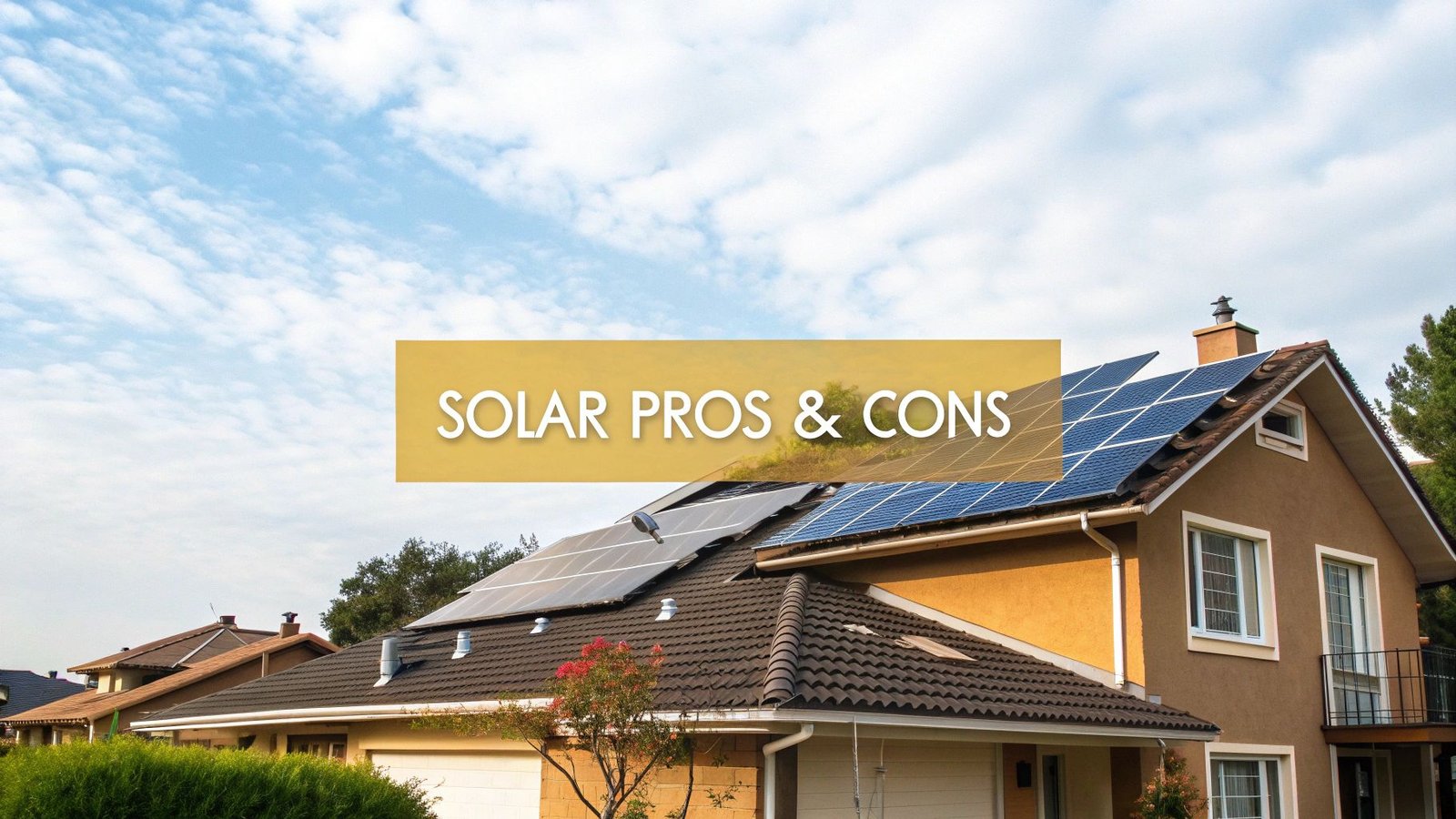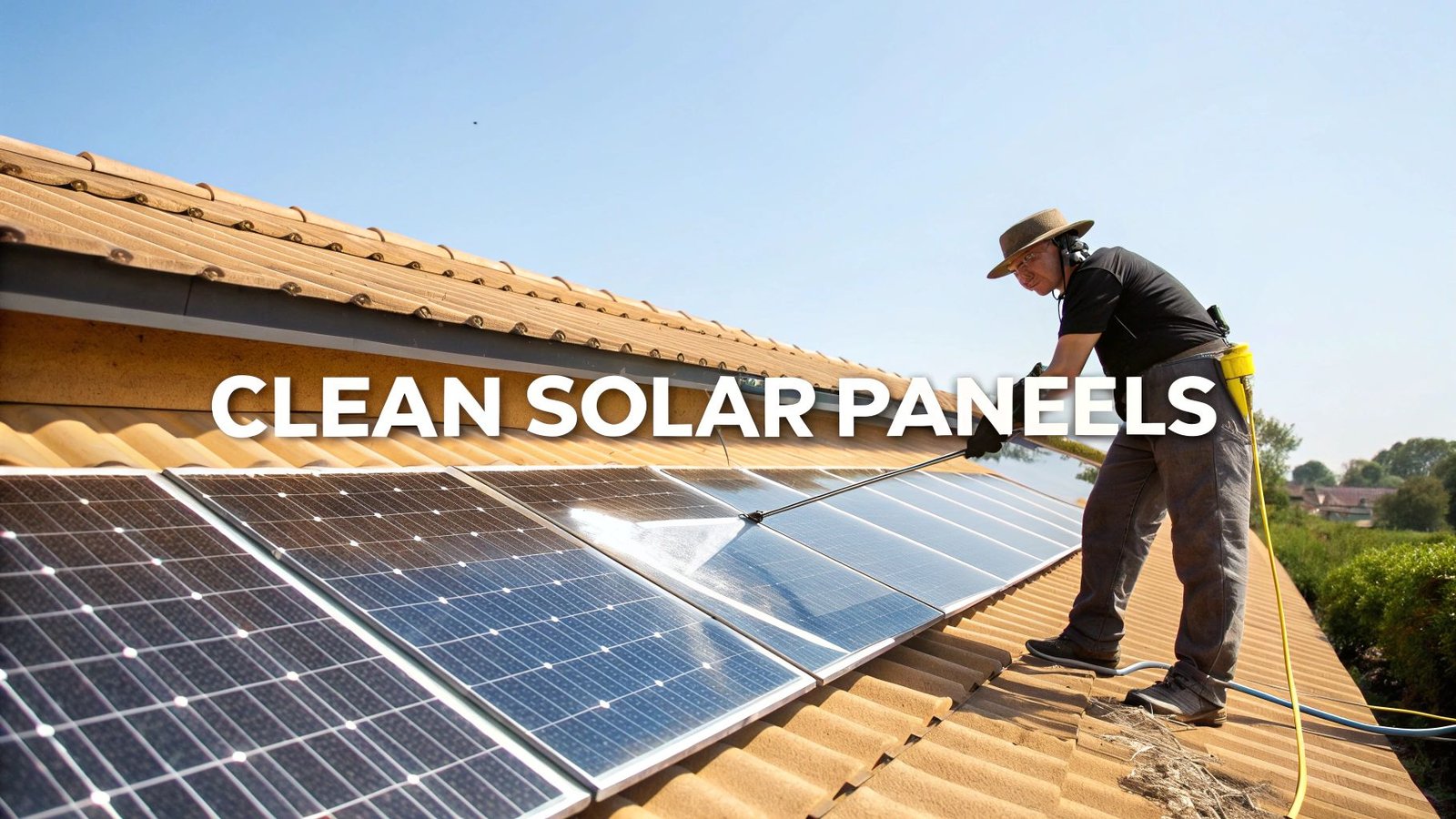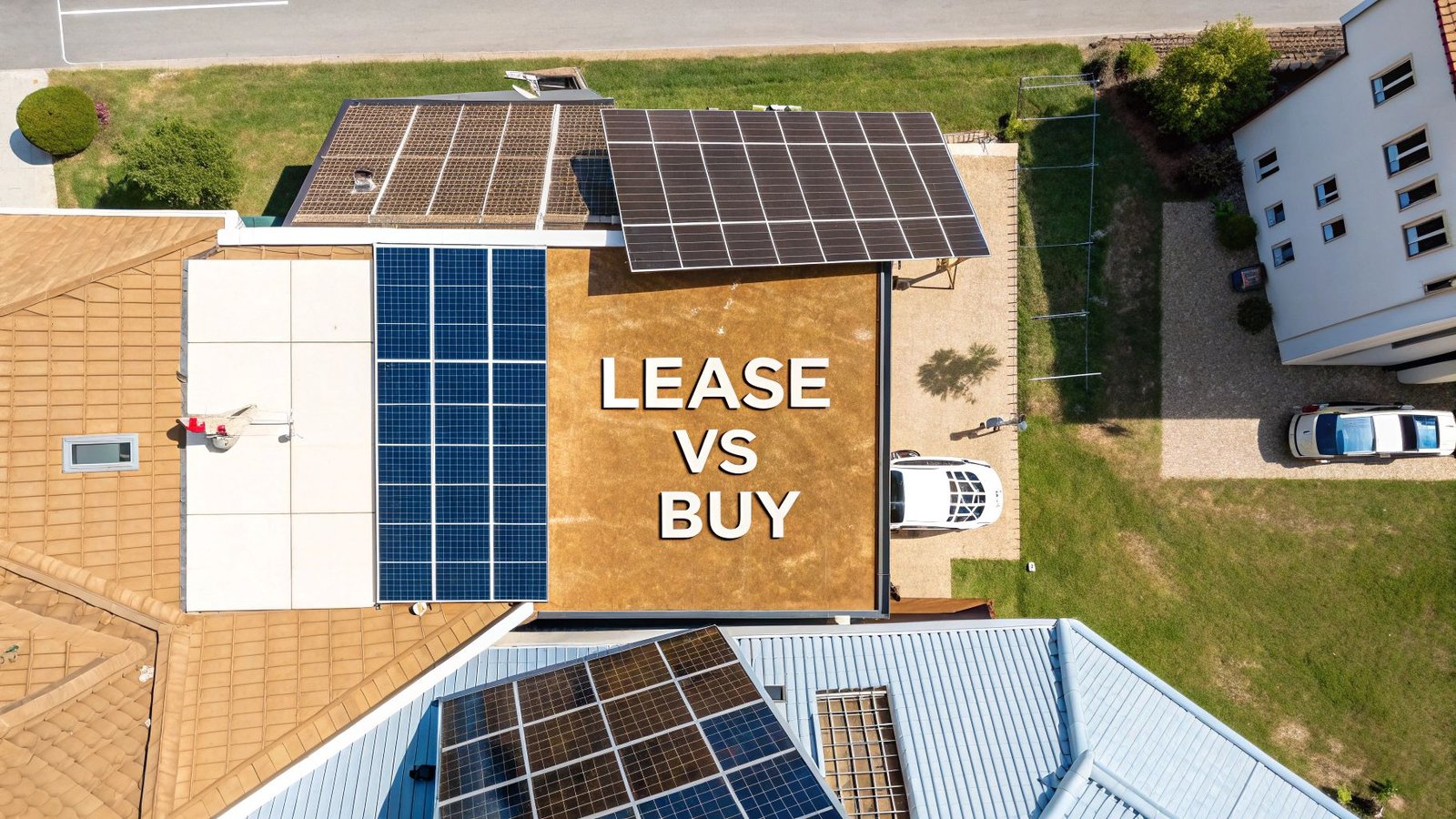Adding solar to your home is an exciting step, but it often brings up an important, and sometimes unexpected, prerequisite: upgrading your electrical panel. Think of your main service panel as the central hub for all the electricity in your house. When you install a solar PV system, you're introducing a powerful new source of energy, and many older or smaller panels simply weren't designed to handle that kind of two-way traffic.
An electrical panel upgrade for solar is all about making sure your home can safely and efficiently manage the electricity your new panels will generate. It’s a foundational step that prevents overloads, ensures you meet modern electrical codes, and truly future-proofs your home for clean energy.
Do You Really Need a Panel Upgrade for Solar?
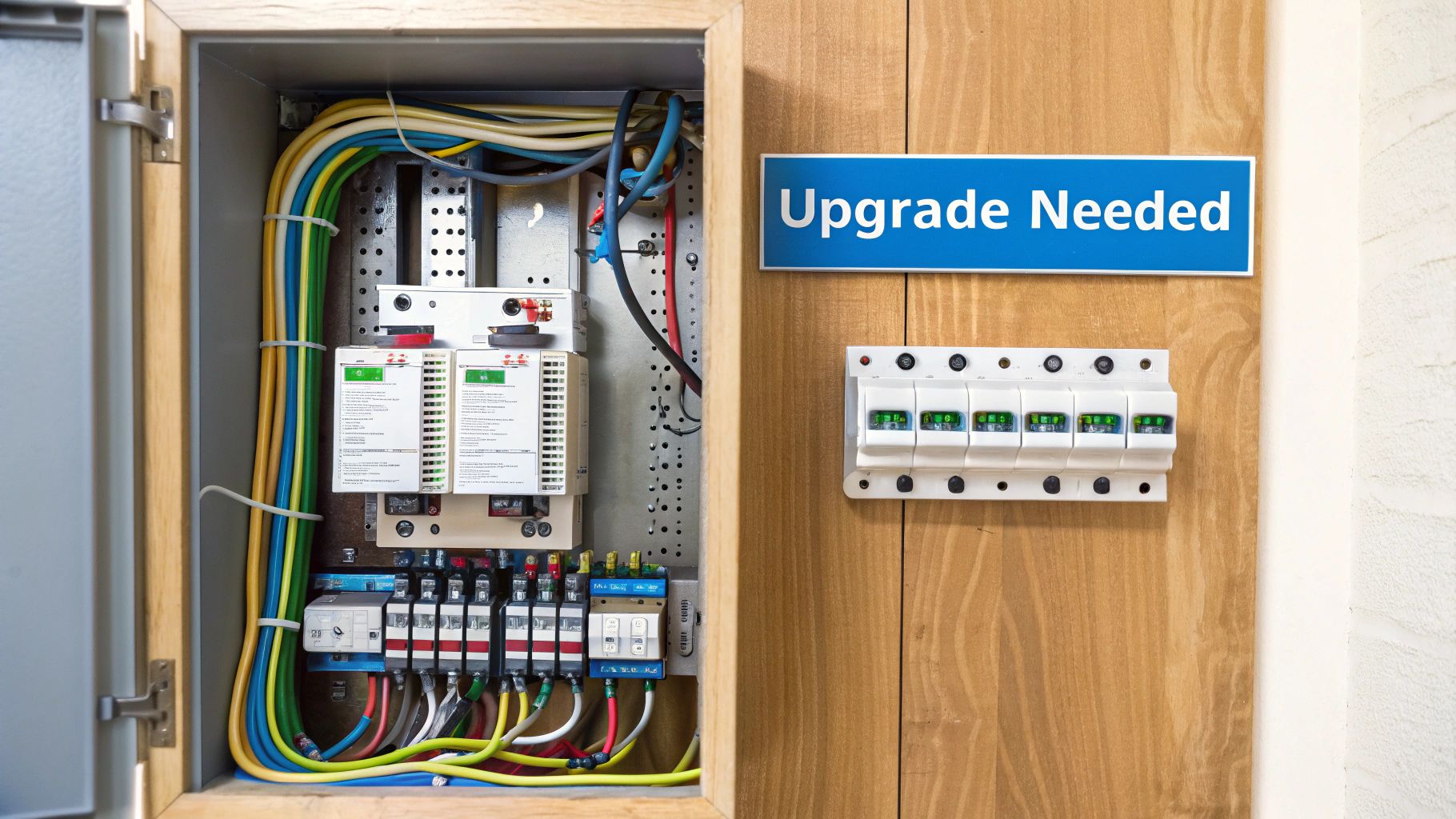
It's a common surprise for homeowners. You’re ready to go solar, but then you find out your existing electrical panel is a roadblock. The reality is, the main service panel is the gatekeeper for all the power in your home, and integrating a solar array means it has to manage power coming in from the grid and power coming in from your roof.
If your home was built before the 1990s, you likely have a 100-amp panel. That panel is already working pretty hard to keep up with modern life—microwaves, computers, big-screen TVs, you name it. Asking it to also handle the output from a solar system is pushing it beyond its limits. It’s a serious safety issue waiting to happen.
Why Your Current Panel Might Fall Short
So, what are the red flags? It’s not just about the age of your panel. The decision to upgrade boils down to three key things: capacity, physical space, and compliance with the current National Electrical Code (NEC).
Here are the most common reasons an upgrade becomes a must-do:
- Insufficient Ampacity: Most homes with solar need a 200-amp panel. This provides enough capacity to safely juggle your regular household electricity demands alongside the new power flowing in from your panels.
- No Room on the Busbar: Your panel needs open slots to accommodate the new breakers for the solar system. If you open your panel and see a wall of breakers with no empty spaces, an upgrade is usually the only way forward.
- Busbar Rating and the "120% Rule": The NEC has a critical safety regulation called the 120% rule. It limits the total power sources feeding a panel's main busbar. Many older panels can't meet this rule once you add solar into the mix, making an upgrade non-negotiable for a safe, code-compliant installation.
The bottom line is safety and performance. An undersized or outdated panel creates a bottleneck that can throttle your solar system's production and, more importantly, poses a potential fire hazard.
Quick Checklist: Is a Panel Upgrade Likely for Your Home?
Use this quick checklist to get a sense of whether your home is a prime candidate for an electrical panel upgrade before going solar.
| Symptom or Factor | Why It Matters for Solar | Upgrade Likelihood |
|---|---|---|
| Panel is 100 Amps or Less | Lacks the capacity to safely handle both home load and solar generation. | Very High |
| No Empty Breaker Slots | There is no physical space to connect the new solar circuit breaker. | High |
| Panel is Over 25 Years Old | May not comply with modern safety codes or could have wear and tear. | High |
| Lights Flicker / Breakers Trip | Indicates the current panel is already overloaded, even before adding solar. | Very High |
| Planning for Future Electrification (EV, Heat Pump) | A 200A panel is needed to support additional high-power appliances. | High |
If you checked off one or more of these, it's a good idea to start the conversation about a panel upgrade with your solar installer right from the beginning.
Keeping Pace with a Growing Industry
The move toward solar is happening fast. In the U.S. alone, there are now over 160 gigawatts of solar capacity installed, a figure that has exploded over the past decade. This incredible momentum means more and more homes need the right electrical infrastructure to support this clean energy technology.
U.S. Solar Capacity Growth (Cumulative)
2014 | ███████ (18 GW)
2016 | █████████████ (36 GW)
2018 | ██████████████████ (56 GW)
2020 | ██████████████████████████ (76 GW)
2022 | ██████████████████████████████████ (110 GW)
2024 | ████████████████████████████████████████████████ (160+ GW)
Source: SEIA/Wood Mackenzie
As solar becomes more mainstream, the electrical panel upgrade for solar is becoming a standard part of the process. To get a better feel for how all the components work together, you can dig deeper into how home solar works. Ensuring your home's electrical system is ready is the key to a smooth and successful transition to solar power.
Key Signs Your Electrical Panel Is Outdated
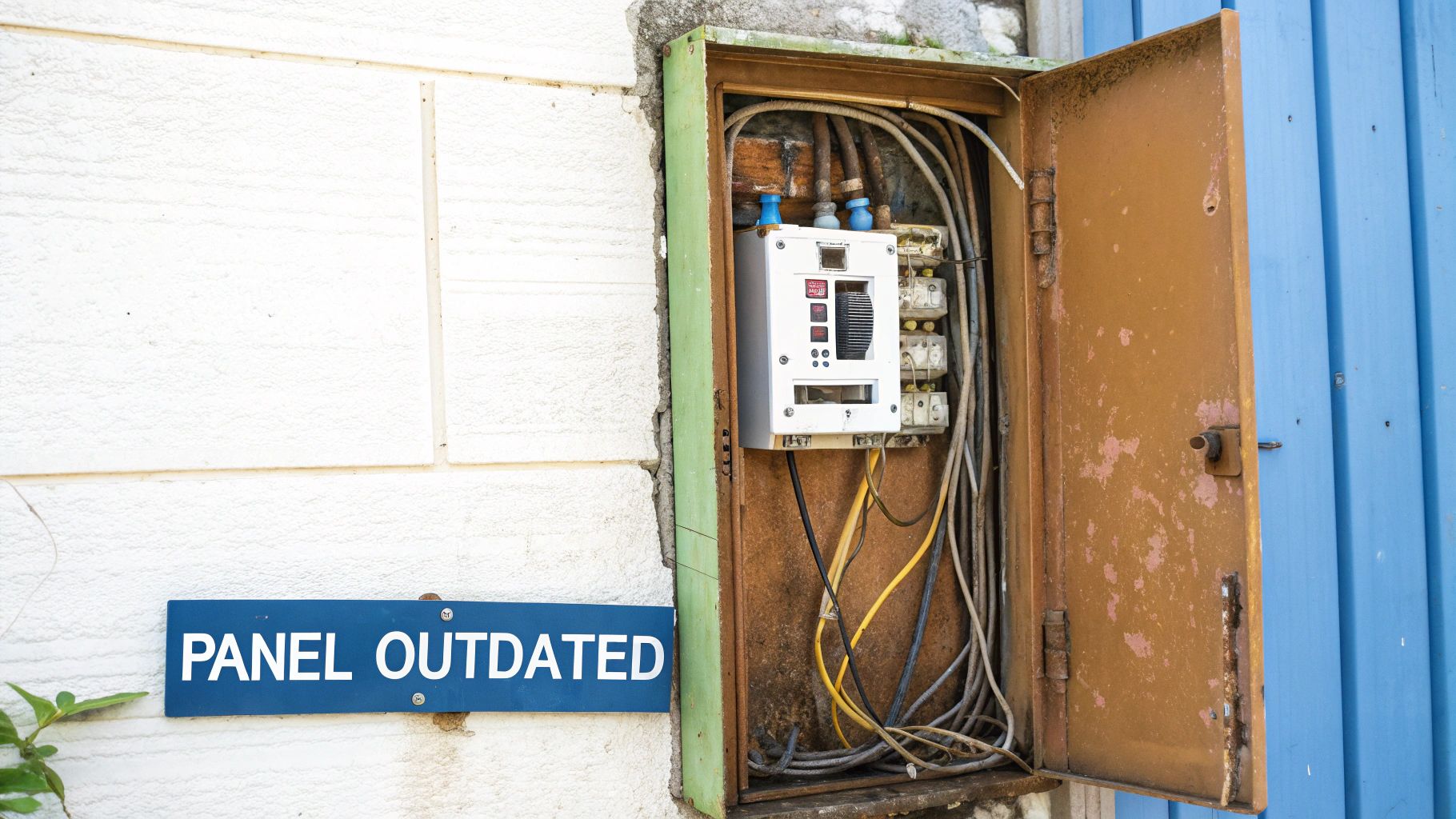
Before you even think about putting a solar array on your roof, you’ve got to make sure your home's electrical panel can handle the new load. The good news is, you don’t have to be a master electrician to spot some of the most common red flags. A quick peek inside the panel door can reveal a lot.
The most telling sign is right on the main breaker. Go take a look. If you see 100A or 125A stamped on it, you can almost guarantee an electrical panel upgrade for solar is in your future. Today’s homes, especially with the added power coming from a solar system, really need a 200A panel to safely manage everything.
Another dead giveaway is a lack of physical space. Carefully open the panel door and just look at the breaker slots. If it’s a full house with no empty spaces, there’s simply nowhere to put the new, dedicated breaker your solar installation requires. It’s an open-and-shut case for an upgrade.
Performance and Age-Related Clues
Beyond the numbers and open slots, your panel’s age and day-to-day behavior can tell you a lot. These things aren't built to last forever. If your panel is pushing 25-30 years old, it was likely installed long before today's much higher safety standards were put in place.
Keep an eye out for these tell-tale signs around your home:
- Flickering Lights: This is a classic. Do your lights dim or stutter when a big appliance like the A/C or microwave kicks on? That's a textbook symptom of a system that’s already overloaded.
- Frequently Tripped Breakers: Breakers are designed to trip to prevent problems. But if you’re constantly heading to the panel to flip one back on, it means your panel is already struggling to keep up with your normal electrical use.
- Visible Wear and Tear: Any signs of rust, corrosion, or scorch marks around the breakers are serious business. This points to internal damage and is a major safety hazard, meaning you need a replacement immediately—solar or not.
A panel that’s already straining under your current electrical load is the last thing you want to connect a new solar system to. Pushing more power through an overworked panel is just asking for trouble and creates unnecessary safety risks.
Comparing Old vs. Solar-Ready Panels
Seeing the differences side-by-side really clarifies why an upgrade isn't just a suggestion, but a necessity for a safe and effective solar installation.
| Feature | Outdated Panel (e.g., 100A) | Solar-Ready Panel (e.g., 200A) |
|---|---|---|
| Max Capacity | Often can't handle modern appliances plus solar. | Easily manages household demand and solar backfeed. |
| Breaker Space | Typically full, leaving no room for new circuits. | Plenty of extra slots for solar and other future needs. |
| Code Compliance | Likely doesn’t meet current NEC safety standards. | Built to modern codes, including the crucial 120% rule. |
| Future-Proofing | Can't support an EV charger or electric heat pump. | Prepared for future electrification projects. |
Budgeting for Your Solar Panel Upgrade
Alright, let's get down to the brass tacks: what’s this going to cost? When you're planning an electrical panel upgrade for solar, the price isn't a simple, flat fee. It's a blend of several factors, from the specific hardware you need to the going rate for a good electrician in your area.
The most common job we see is a homeowner upgrading from an old 100A panel to a new 200A one. For just that swap, you're typically looking at a range of $1,200 to $2,500. But think of that as a baseline. The actual complexity of your home’s wiring and the cost of local permits can definitely influence the final number.
Typical 100A to 200A Panel Upgrade Cost Range
$1,200 |█████████████
|
|
|
$2,500 |██████████████████████████████
--------------------------------------------------> Price
Breaking Down the Core Costs
Every house tells a different story with its wiring. Some are straightforward, making for a relatively quick job. Others, especially older homes, can hide surprises that require more labor and materials to bring everything up to modern standards.
Here’s a look at what actually goes into the quote you’ll receive:
- The Panel Itself: This is your main material cost, covering the new 200-amp panel and all the necessary breakers.
- Labor: You’re paying for a licensed electrician's time and expertise, and those hourly rates can vary quite a bit depending on where you live.
- Wiring Complexity: If the electrician discovers old wiring that isn’t up to code, that will expand the scope of the project and add to the cost.
- Permit and Inspection Fees: Your local municipality requires permits and inspections to ensure the work is done safely, and they charge fees for this oversight.
This infographic gives a pretty good visual breakdown of how those costs tend to split in a typical upgrade.
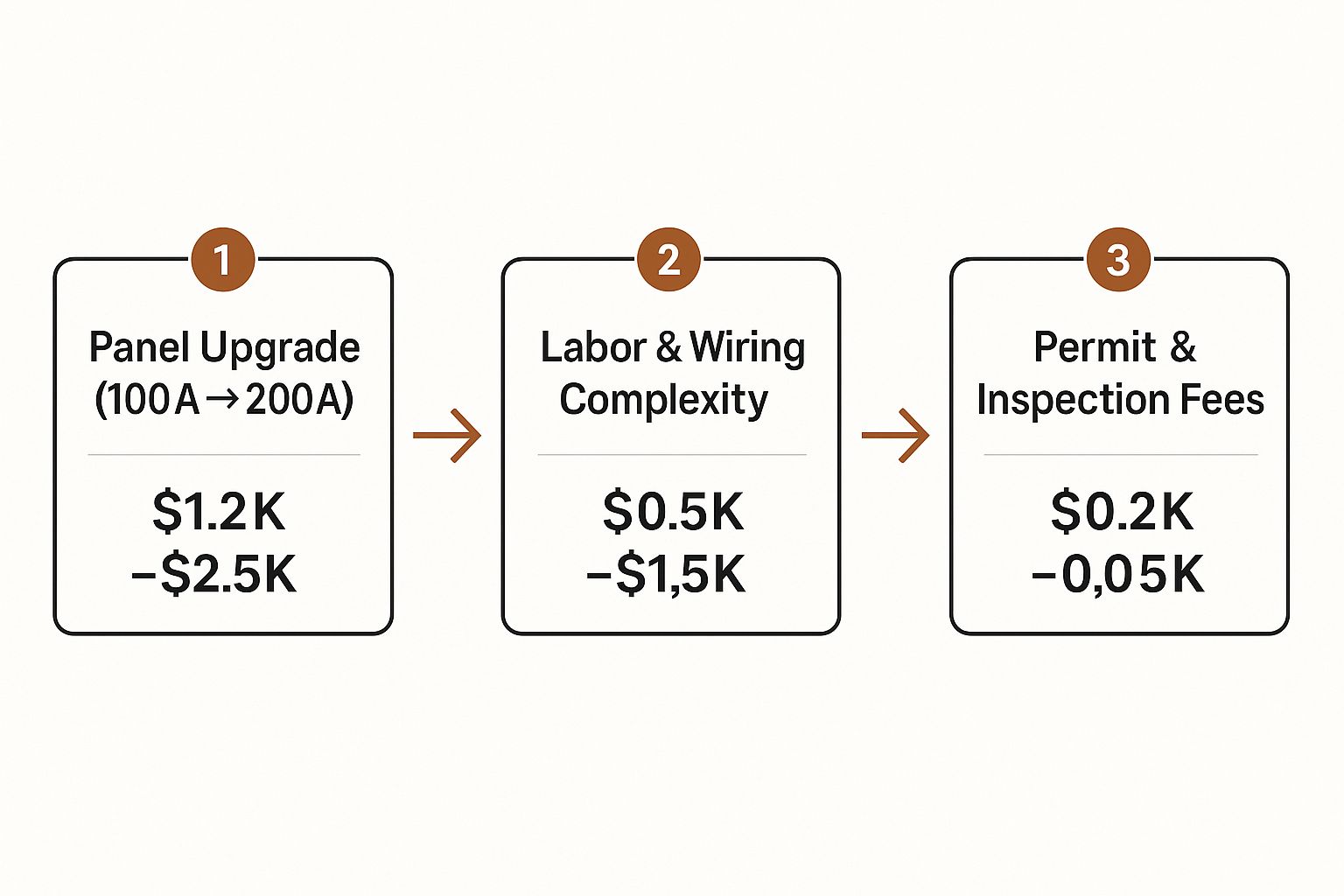
As you can see, the panel hardware is the biggest chunk, but labor and permits are significant pieces of the puzzle you can't ignore when budgeting.
Factoring the Upgrade into Your Total Solar Investment
While it's easy to see the panel upgrade as just another line item, it's really a foundational piece of your entire solar project. The good news is that the overall cost of solar has become much more manageable over the years. A typical residential solar system runs about $30,000, but it can generate lifetime savings anywhere from $27,000 to $110,000. The panel upgrade is what makes those long-term savings possible.
To get a clearer sense of the bigger financial picture, you can learn more about solar panel system installation costs and how it all comes together.
My advice? Don't view the panel upgrade as a separate, annoying expense. See it as an essential investment that unlocks the full potential and safety of your new solar system. It’s the platform the whole thing is built on.
It’s also worth looking into local incentives. Some states have fantastic rebate programs that can soften the financial blow. For example, Wisconsin's Home Electrification and Appliance Rebates (HEAR) program can cover a hefty portion of an electrical panel upgrade for qualifying households, making it much easier to go solar.
What to Expect During the Upgrade Process
The thought of an electrical panel upgrade for solar can sound pretty intimidating, almost like a major home renovation. But for a licensed electrician, it's a routine job. Knowing what's coming helps take the mystery out of the process and shows you exactly how it slots into your bigger solar installation project.
It all kicks off with a professional consultation. Your electrician will pop the cover off your current panel, size up your home's total electrical demand (factoring in the new solar system, of course), and help you land on the right panel. More often than not, this means a 200-amp panel that can handle everything you have now and whatever you might add down the road.
Navigating Permits and Paperwork
With a new panel picked out, the next step is all about paperwork. Your electrician will take the lead on pulling the necessary permits from your local building department. This isn't optional—it’s a crucial step that guarantees the work is safe, up to code, and ready to pass the final inspection.
Getting a handle on local requirements is a big part of the puzzle. You'll want to be prepared for navigating the building permit checklist to keep your project on the right side of the regulations. Permit approval times can be a bit of a wildcard, ranging from a few days to several weeks depending entirely on how swamped the local office is.
What to Expect on Installation Day
This is when the real work gets done, and it’s usually a one-day affair. The whole process follows a strict, methodical order to ensure everything is done safely and correctly.
A Typical Installation Day (6-8 Hours):
- Arrival (First Hour): The electrician shows up, sets up their workspace, and calls the utility company to shut off power to your house. This is when the planned outage begins.
- The Swap (Next 3-4 Hours): Out with the old, in with the new. The old panel is disconnected and removed, and the new, higher-capacity panel is mounted in its place.
- Rewiring (Next 3-4 Hours): This is the most detailed part. Every single circuit in your home is carefully wired into a brand new breaker. The main service line and the dedicated solar backfeed breaker are also connected.
- Power Up (Final Hour): After double-checking everything, the electrician neatly labels all the new breakers. Then, they coordinate with the utility to get your power back on.
Your home will be without power for most of the day. It’s a good idea to charge all your devices beforehand, figure out a plan for anything in the fridge, and just generally prepare for a day off the grid.
The last piece of the puzzle is the official inspection. A city or county inspector will stop by to give the work a final look-over, making sure the new panel and all the wiring meet the latest National Electrical Code (NEC) standards. Once it passes, you're officially cleared to connect your solar system and take a huge step toward energy independence.
Future-Proofing Your Home Beyond Just Solar
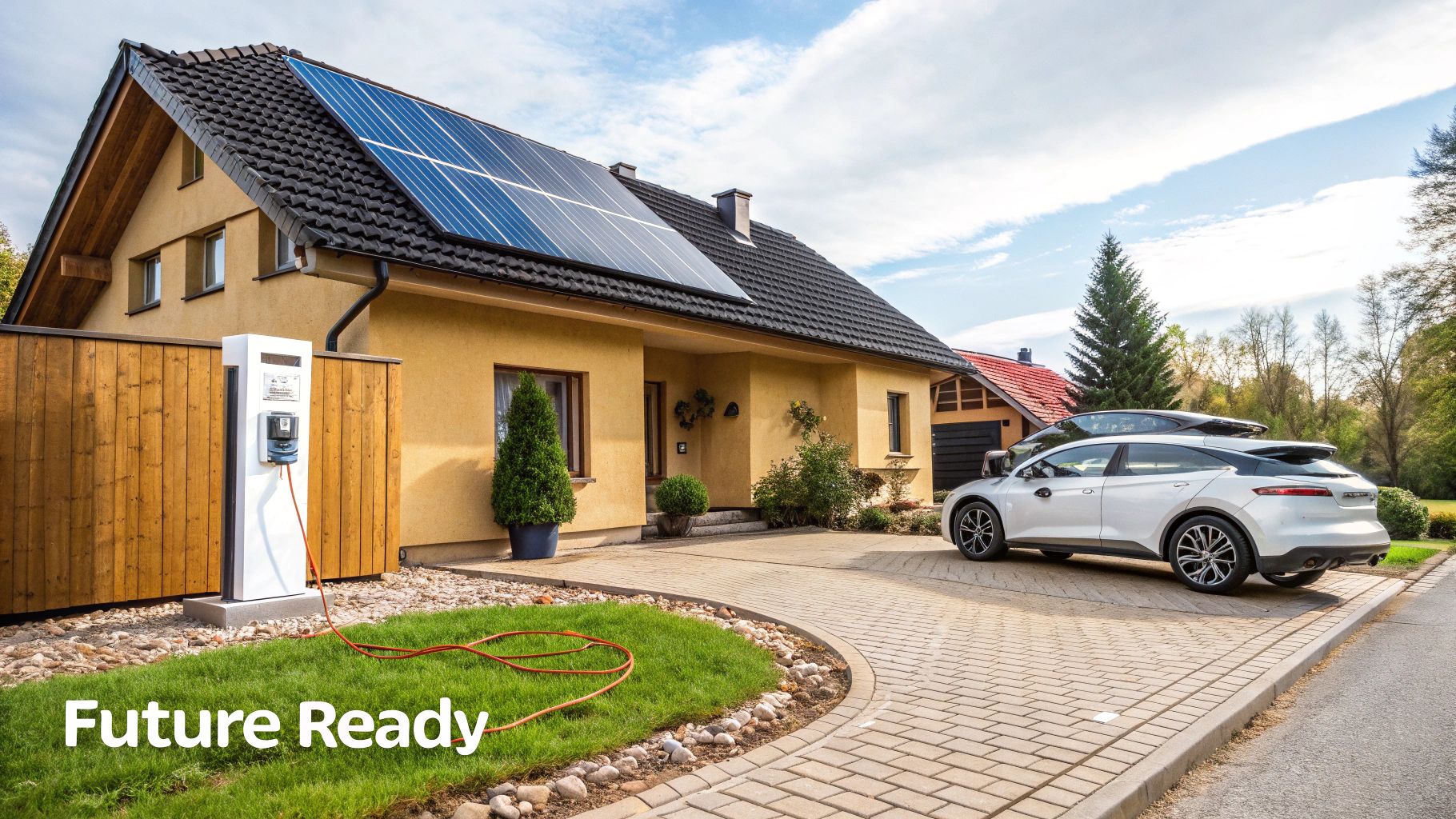
When you upgrade your electrical panel for a solar installation, you're doing much more than just checking a box. Think of it as a strategic investment in your home's future—its value, its capabilities, and its readiness for what's next.
Installing a modern 200-amp panel doesn't just make solar possible. It lays the groundwork for the inevitable shift toward total home electrification, giving your house the robust electrical backbone it needs for a truly modern, sustainable lifestyle. It's about getting ahead of the curve so you aren't forced into another expensive overhaul a few years from now.
Preparing for the All-Electric Future
The conversation about home energy has moved past just solar panels. It’s now about the entire ecosystem: how you generate, store, and use power. Upgrading your electrical panel is what unlocks this potential, opening the door to a whole suite of high-efficiency, electric-powered technologies.
With a 200-amp panel, you'll have plenty of capacity for power-hungry additions that are quickly becoming standard:
- EV Chargers: A Level 2 EV charger draws a significant amount of power. Most older 100-amp panels simply can't handle that load safely on top of a solar system and other major appliances.
- Heat Pumps: These incredibly efficient all-in-one heating and cooling systems are fully electric and demand their own high-amperage circuit.
- Battery Storage Systems: To get the most out of your solar investment and achieve real energy independence, you need a way to store that power. Our guide on battery backup systems for homes explains how these integrate with your panel to keep the lights on during an outage.
By thinking ahead, you ensure your home is ready for these additions without the disruption and cost of a second major electrical project. It’s about doing it once and doing it right.
This forward-thinking approach at home mirrors a massive shift happening at the national level. In the United States, utility companies recently added about 30 gigawatts of solar—enough to power over 3 million homes. This huge investment makes it clear where our energy future is headed and why it's so important for our homes to have the right infrastructure to keep up.
Panel Capacity and Future-Ready Technology
It’s often hard to visualize just how limiting an older panel can be. This table breaks down what's possible at different amperage levels, showing how a 200A panel truly unlocks your home's potential.
| Panel Size | Supports Solar PV | Supports EV Charger | Supports Heat Pump | Supports Battery Storage |
|---|---|---|---|---|
| 100A | Rarely | No | No | Limited |
| 125A | Sometimes | Unlikely | Unlikely | Limited |
| 200A | Yes | Yes | Yes | Yes |
As you can see, the jump to 200 amps is less of an incremental step and more of a complete transformation. It’s what separates a home that’s merely "solar-compatible" from one that’s truly future-ready.
Your Panel Upgrade Questions, Answered
Deciding to upgrade your electrical panel for solar is a big step, and it's natural to have questions. Getting straight answers is the best way to feel good about the project, so let's walk through what homeowners usually want to know.
Can I Get Solar Without a Panel Upgrade?
It's not impossible, but it's pretty rare. Whether you can skip the upgrade comes down to your panel's current capacity and the strict rules in the National Electrical Code (NEC).
The NEC has what's known as the "120% rule," which puts a hard limit on how much power your solar system can feed back into your panel's main busbar. If you have a newer, 200-amp panel, you might just have enough space for a smaller solar system. But if you’re working with an older 100-amp panel, an upgrade is almost always a given.
Only a certified electrician can give you a definite answer after running a full load calculation. For most homes, especially those built more than 20 years ago, upgrading is an essential part of making the switch to solar safely and legally.
A lot of people think having empty breaker slots means they're good to go for solar. That's a common mistake. The real issue is the busbar's ampacity rating and whether it can handle the extra load according to the NEC's 120% rule. This is exactly why you need a pro to look at it.
How Long Does the Panel Upgrade Actually Take?
The hands-on work is usually done in a day, but the whole process takes a bit longer. On the day of the swap, you can expect the power in your house to be out for about 6 to 10 hours.
But getting to that point involves a few steps, and the total timeline is more spread out.
Panel Upgrade Timeline Breakdown
Planning/Permitting: █████████████████████████ (1-4 Weeks)
Installation Day: ███ (6-10 Hours)
Final Inspection: ██████ (2-5 Days)
All told, you should probably plan on the entire upgrade process taking somewhere between two and five weeks from start to finish.
Will a Panel Upgrade Increase My Home's Value?
Yes, absolutely. A modern electrical panel is a huge plus for any home. It tells potential buyers that the house is safe, up-to-date, and ready for whatever they want to throw at it.
Think about it from a buyer's perspective. Seeing a new 200-amp panel means they won't have to worry about a major electrical project down the road. It signals that the home is ready for an EV charger, a heat pump, or a full suite of smart home gadgets. When you pair that with a solar installation, you're showcasing a forward-thinking home that's built for the future—and that's something people will pay for.
Who Should I Hire to Do the Upgrade?
This is a job for a licensed electrician, no question. But you have a couple of ways to go about it.
Many solar companies have their own in-house electricians or a list of trusted subcontractors they work with regularly. This is often the smoothest path because they handle all the coordination between the panel work and the solar installation. It just works.
You can also hire your own independent electrician. If you do, make sure they are in constant communication with your solar installer. The new panel has to be specced out perfectly for the solar system. When you're dealing with a project like this, finding a reliable contractor online is critical to making sure everything is done right. No matter which option you choose, always double-check their license and make sure they pull all the required permits before starting.
At Radiant Energy, we handle every step of your solar journey, including coordinating a seamless electrical panel upgrade with certified professionals. If you're ready to make your home future-ready with solar, visit us at https://radiantenergysolar.com to get started.

